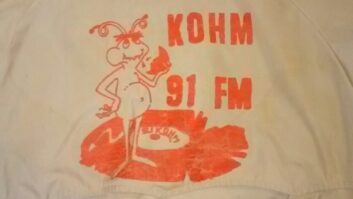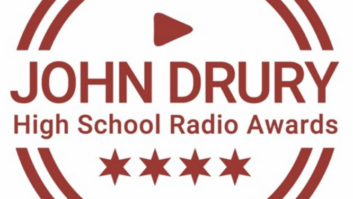Comrex’s Access Codec, ‘Connexion By Boeing’ Serve as Wingmen as Show Airs From the Sky
On April 22, an unusual radio first was accomplished. Peter Greenberg, host of the syndicated “Travel Today,” broadcast his entire talk radio show from a moving commercial aircraft, utilizing a combination of Internet and broadcast technology.
Greenberg is a travel journalist and editor for NBC’s “Today” Show, chief correspondent for the Travel Channel, travel author and host of “Travel Today,” a show originating from wherever in the world he happens to end up. In the process, he logs about 400,000 miles a year.
For Greenberg, the phrase “air miles” now has a new meaning.
Sky-high Access
Greenberg said in the show’s opening: “Every week when I say ‘welcome aboard,’ we’re at a different location on the ground. Today, ‘welcome aboard’ means something else, and if you haven’t guessed it already, we’re talking to you from about 37,000 feet in the air.”
Although codecs and the Internet have been employed in the broadcast environ for some time, their successful marriage allows for non-terrestrial broadcasting with a reliability and audio quality hitherto unprecedented.
As ISDN resources become harder to find, and the older traditional methods of remote broadcasting all but extinct, broadcasters have once again had to become creative in methods of transporting high-quality – and, ideally, minimally latent – audio from point-to-point.
With the widening of the long-distance telecommunications infrastructure in the 1980s and ’90s, the world shrank. But as the availability of various telecom products followed paths created by market demand, the various methods of shipping audio around the globe changed, as such services like Switched 56 morphed into ISDN.
Now the IT world is jumping ship to means that are less expensive and more flexible. This has left broadcasters and video conferencing alone as the primary ISDN patrons. Major telecommunications providers are left to rethink their support of ISDN, and broadcasters are starting to look elsewhere for their remote broadcasting connectivity.
In March 2005, engineers from Comrex began field-testing a new technology they labeled BRIC, which stands for Broadcast Reliant Internet Codec.
As we have all experienced, the Internet can be a precarious terrain for the demands of broadcast audio, with its intolerance to interruption and self-centered requirement of audio quality. Unlike other data-transmission consumers, the broadcast world doesn’t take too kindly to frequently retransmitted packets and network congestion.
What was needed was a means of expanding the reliability of the Internet as a ubiquitously accessible vehicle, being flexible and friendly to entrance ramps that are DSL, Wi-Fi, cable modems and even high-speed cellular. Comrex said its testing of BRIC proved that, with a careful balancing of buffering suited to the characteristics of a given network, it could be done.
BRIC was soon incorporated into the manufacturer’s appropriately named Access, a codec designed to work in digital and POTS neighborhoods.
According to the company, the Access operates on several levels depending on the job and the digital resources available from the network. BRIC HQ-1 results in a 15 kHz audio bandwidth, operating at 28 kbps, and allows for mono or stereo transmission. A dual-mono capability is featured and the inherent delay is kept to a minimum. BRIC HQ-2 is the next level, featuring a 12-15 kHz frequency response resulting from a 24 kbps bitstream.
If ramped up to 24-30 kbps, stereo is achievable with a delay comparable to ISDN. Scaling the frequency response down to 12 kHz lessens artifacts and is allowable. A “speech-friendly” setting of BRIC HQ-3 provides quality voice transmission at challengingly low bit rates (i.e., 10 kbps). The result is similar to G.722 in sound, but utilizes one-sixth the amount of data. Hence, stability is enhanced without a submersion into the swimming pool of artifacts. An MPEG-4 AAC algorithm is available as an option to this mode.
Finally, Access is backward-compatible to previous POTS codecs. About the size of a paperback book, the Access connects to the Internet via Ethernet port, 3G Cellular, Wi-Fi or Wi-Max card, or modem. Its battery pack provides about seven hours of broadcast time per charge.
The Comrex Access was employed for this flight, the world’s first full-length broadcast from a moving trans-Atlantic flight. Using “Connexion by Boeing” high-speed in-air internet service – which, using an aircraft to satellite link, allows any Windows 95 + or Apple OS-9/OS-X laptop with a Wi-Fi card to connect to the internet – Peter Greenberg broadcast while en-route from Frankfurt to New York.
Line-of-sight at 37,000 feet
Engineer Mike Worrall performed his first test of the BRIC package while on a Lufthansa flight to Germany on Friday, April 14, and reported that it was “completely successful.” During the 20-minute glitch-free test, Mike observed a 1.25 second delay in the recovered audio, which he felt was quite “workable,” considering delays inherent in the buffering, network congestion and coding.
Comrex’s BRIQ HQ-1 setting provided an audio bandwidth of 15 kHz of duplex mono.
But as Worrall explains, the technology worked perfectly; but the human element did not.
“Though we had coordinated our ‘test flight’ with both the Lufthansa Public Relations and Engineering departments, somehow the Los Angeles ground crew failed to get word to the pilot and purser that Lars and I would be on board,” said Worrall. “We were about 20 minutes into our test, when apparently one or two other passengers inquired of the stewardesses what we were up to, wearing ‘sports’ headsets and talking animatedly to an obvious third party. A few minutes later the captain appeared, clearly upset – and understandably so – about what must have appeared to be a clandestine communications system.
“He forcefully ‘asked’ us to turn our equipment off – immediately – and of course we complied. So, while we were able to make a brief connection, our ‘test flight’ was far from the conclusive test we had hoped for,” he said.
On April 22, Greenberg took the show into the air aboard an Airbus A330 Lufthansa flight from Germany to New York. The two-hour broadcast, could be heard on radio, podcast and – appropriately enough – the Internet. It went flawlessly, said Worrall, an effort involving engineers at Boeing Connexion, Lufthansa and Comrex.
As Lars Hansen from Boeing explained near the beginning of the show, the link was provided by connecting Greenberg’s Comrex Access equipment to a server aboard the aircraft, in the same fashion that any traveler may now gain Internet access via their laptop when using Boeing’s Connexion service.
The data was transmitted from the aircraft to satellite, where it was downlinked at the Connexion site in Littleton, Colo., to be interfaced with the Internet. The IP connection to KABC – home studio of “Travel Today” in Los Angeles – then sent the audio to New York via linear T1 for network distribution. Callers participating on the show on mix-minus were linked from New York via ISDN to KABC, back to Littleton as packets, up into space and back to the aircraft. The KABC midpoint served as a backup in case of trouble in New York.
This cross-connection of terrestrial and Earth-bound bit streams became particularly interesting when at one point in the show a friend of Greenberg’s called in from yet another Lufthansa aircraft in flight utilizing a similar satellite/data connection.
To the user, logging into Boeing’s “Connexion” is the same as logging into a WiFi or Ethernet connection, such as those found at a hotel where a “fee-based service” is found (other airlines now offer similar services such as Tenzing and Sky Way Aircraft).
“If you’ve not experienced this, one simply opens Internet Explorer and is presented with a ‘Welcome to This Fee-Based Internet Portal’ screen. [You] then provide credit card details and [are then] connected to the Internet,” Worrall said.
To get an idea of the cost, with Lufthansa for instance, you can purchase an entire flight’s worth of service for about $30. Airlines offering this service post the rates on their Web sites. An option to pay by minute also is available. The cost is scaled by usage, so the cost per minute increases as the total amount of time is decreased.
Worrall also notes that for overseas flights between Europe and North America, there is a transition that occurs between the between satellites serving the two continents. This creates a “downtime” of about 90 seconds where the connection is broken. In the meantime, the two Access units continuously call for each other and automatically reconnect. For this particular broadcast, Boeing was able to force the switch about 15 minutes prior to airtime.
The actual connection time, Worrall reports, was “amazingly fast; I’d guess less than a second,” he said. Because the Comrex Access didn’t “dial out” in the conventional sense, simply connect to the IP address of the Access you wish to “converse” with.
Worrall reports that data latency created only about a 1.5 second delay for most of the transmission, and in listening to the show the audience would have little to clue them in on the complexity of the signal path. There was no awkward hesitation between host and caller, and the flow of the conversation was as natural as a call across the street for pizza. The BRIC HQ-1 algorithm inherently possesses a 60 ms delay. Switching to HQ-2 would have increased this figure to 360 ms, making interviews a little awkward, but would have reduced artifacts if these become noticeable.
Curiously enough, the FCC has not authorized any on-board Internet service on aircraft flying between domestic destinations thus far. One can utilize Connexion By Boeing while over U.S. airspace during an international flight, but only once en-route or returning from an overseas airport. If you are en-route to another U.S. city for transfer, you cannot utilize the service.












